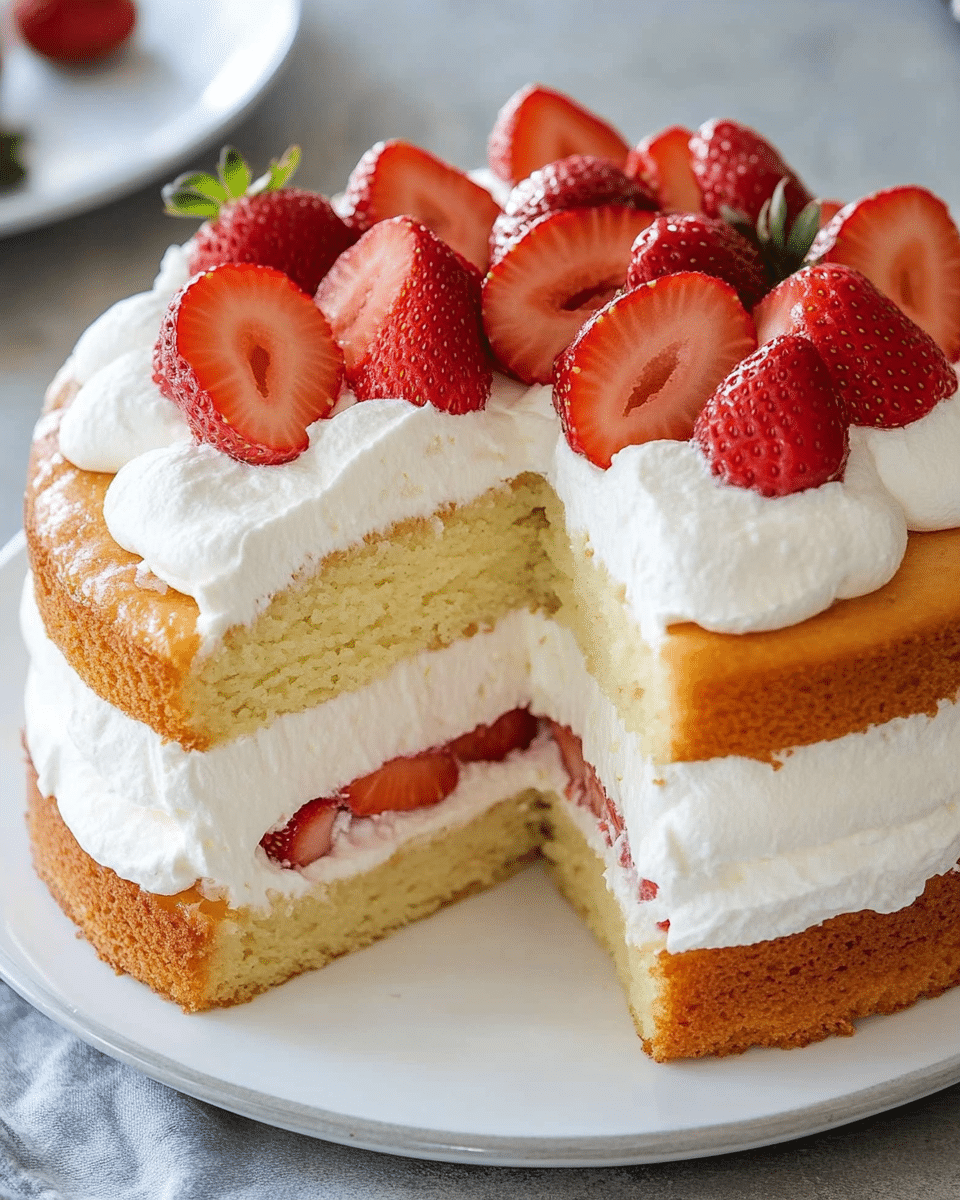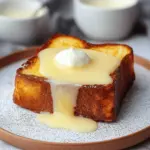Japanese Strawberry Shortcake is a beloved dessert in Japan, particularly popular for birthdays and celebrations. Unlike its Western counterpart, this version features an ultra-light sponge made without baking powder, relying solely on whipped eggs for volume. Sandwiched between these airy layers is a lightly sweetened whipped cream and fresh strawberries, creating a refreshing balance of flavor and texture. The cake is often frosted with more cream and topped with vibrant strawberry halves for a beautiful, minimalist aesthetic. What makes this cake truly special is its elegant simplicity. It’s not overly rich or heavy, making it perfect even after a full meal. The emphasis on freshness using only ripe strawberries and real cream brings out the natural flavors of each component. Whether you’re making it for a loved one’s birthday or simply want to enjoy an authentic taste of Japanese patisserie at home, this cake delivers on both presentation and taste in the most delightful way.
Full Recipe:
Ingredients:
-
4 large eggs, at room temperature
-
120g (1/2 cup + 1 tbsp) caster sugar
-
120g (1 cup) cake flour, sifted
-
40g (3 tbsp) unsalted butter, melted
-
40ml (2.5 tbsp) whole milk
-
1 tsp vanilla extract
Whipped Cream Filling & Topping:
-
500ml (2 cups) heavy whipping cream (35% fat)
-
40g (3 tbsp) powdered sugar
-
1 tsp vanilla extract
-
1 punnet (250g) fresh strawberries, halved or sliced
Directions:
-
Preheat oven to 170°C (340°F). Grease and line two 18cm (7-inch) round cake pans with parchment paper.
-
Place eggs in a large mixing bowl and beat on high speed with an electric mixer for about 1 minute.
-
Gradually add sugar and continue to beat for 7–8 minutes until the mixture triples in volume and becomes pale and thick.
-
Sift in the flour in three additions, gently folding each time with a spatula to maintain volume.
-
In a separate bowl, combine melted butter, milk, and vanilla. Add a scoop of the batter into the butter mixture and stir to combine.
-
Gently fold this mixture back into the main batter until fully incorporated.
-
Divide the batter evenly between the prepared pans. Tap pans gently to remove air bubbles.
-
Bake for 25 minutes or until a toothpick inserted comes out clean. Let cool in pans for 10 minutes before turning out onto wire racks to cool completely.
-
Whip the cream, sugar, and vanilla extract until soft peaks form.
-
Trim cake tops if domed. Spread whipped cream and strawberry slices between layers. Cover top and sides with more whipped cream and decorate with remaining strawberries. Chill for 1–2 hours before serving.
Prep Time: 25 minutes | Cooking Time: 25 minutes | Total Time: 50 minutes
Kcal: 390 kcal | Servings: 8 slices
The Art of Japanese Strawberry Shortcake: A Delicate and Elegant Dessert
Japanese Strawberry Shortcake, or Ichigo Shōtokēki (いちごショートケーキ), is one of Japan’s most iconic and beloved desserts. Unlike its American namesake, which typically features dense shortbread or biscuit layers, this version is characterized by its light and fluffy sponge cake layers, a generous amount of freshly whipped cream, and sweet, juicy strawberries. This cake is a staple in Japanese patisseries, gracing the shelves year-round but especially shining during the holiday season and birthdays.
The elegant simplicity of this dessert is what makes it so distinct. From its airy texture to its beautiful, minimalist presentation, Japanese Strawberry Shortcake epitomizes the concept of “less is more.” It is a dessert that doesn’t rely on heavy frostings or excessive sweetness, but rather focuses on harmony between the sponge, cream, and fruit. It’s both a visual and culinary delight.
Origins and Cultural Significance
Though Western-style cakes were introduced to Japan during the Meiji Restoration in the late 19th century, it wasn’t until the post-World War II era that Western confections became widespread. Japanese pastry chefs took inspiration from French and American cakes but adapted them to suit Japanese palates, which typically favor less sugar and lighter textures.
The Japanese Strawberry Shortcake as we know it today became popular in the 1970s, when it was promoted by Fujiya, a long-standing confectionery company. Since then, it has become a national symbol of celebration. It’s commonly served at Christmas, birthdays, and special occasions, with its red-and-white color scheme evoking the festive spirit and even resembling the colors of the Japanese flag.
The cake’s popularity has only grown over time, and it’s now a standard menu item in bakeries and cafés throughout Japan. Its reputation has extended globally, admired for its refined aesthetic and clean, delicate flavors.
Why Japanese Strawberry Shortcake Stands Out
1. The Sponge Cake Base
The base of this dessert is a castella-style sponge that is ultra-light and soft. Unlike most Western cakes that use baking powder or soda for rise, Japanese sponge cake relies entirely on whipped eggs to create volume. This technique produces a tender, cloud-like crumb that practically melts in your mouth.
What’s notable about this method is the precision and care required ingredients must be measured accurately, eggs whipped to the right consistency, and the batter folded with patience. The result, however, is worth the effort. The sponge isn’t overly sweet, which allows the natural flavors of the whipped cream and strawberries to shine through.
2. Fresh Whipped Cream
Japanese whipped cream is another key component that differentiates this cake from other layered desserts. Instead of using sugary buttercream or frosting, the cream is lightly sweetened and whipped to soft peaks. This not only maintains the delicate feel of the cake but also ensures the overall flavor profile remains light and refreshing.
The texture is silky and rich, without being heavy. It’s often described as being “airy” or “cloud-like,” making it the perfect partner for the sponge cake layers and fresh strawberries.
3. Strawberries as the Star
Strawberries are the central fruit in this dessert for good reason. Their bright color and sweet-tart flavor pair beautifully with the whipped cream and sponge. In Japan, there’s even a variety of strawberries cultivated specifically for desserts plump, aromatic, and naturally sweet.
The strawberries are typically sliced and layered between the cakes along with the whipped cream, with more adorning the top for an eye-catching presentation. Their natural juiciness provides a refreshing contrast to the richness of the cream and the soft texture of the cake.
4. Aesthetic Appeal
Japanese Strawberry Shortcake is as much about presentation as it is about flavor. It’s often frosted smoothly with whipped cream and topped with strawberries arranged symmetrically or artfully. The result is a cake that looks refined and elegant, often described as “cute” or kawaii in Japanese culture.
Unlike more decadent Western cakes with elaborate decorations or intense flavor profiles, this cake emphasizes restraint and balance. The clean lines, soft hues, and minimalistic garnishing reflect a deep-rooted Japanese cultural appreciation for harmony and beauty in simplicity.
Serving Occasions and Pairings
This cake is suitable for nearly any occasion birthdays, anniversaries, holidays, or just an afternoon tea. It has become Japan’s unofficial Christmas cake, with millions of families buying or baking it each year during the holidays. But it’s also an excellent year-round treat, especially during spring and early summer when strawberries are at their peak.
Japanese Strawberry Shortcake pairs beautifully with light beverages. A cup of green tea or jasmine tea enhances the fruity notes and cuts through the richness of the cream. For Western pairings, a mild black tea, such as Darjeeling or Earl Grey, works just as well. If you’re looking for something chilled, try serving it with sparkling water or a glass of dry rosé wine.
Tips for Making the Perfect Japanese Strawberry Shortcake
Crafting this dessert at home requires a bit of technique and finesse, but it’s entirely achievable with the right approach. Here are a few expert tips to keep in mind:
-
Use room temperature eggs: This ensures they whip up to maximum volume.
-
Sift the flour: This prevents clumps and helps keep the batter airy.
-
Don’t over-mix: Fold gently to maintain the air in your batter.
-
Use high-fat cream: Look for cream with at least 35% milk fat for a stable whipped texture.
-
Choose ripe, sweet strawberries: The fresher the fruit, the better the taste and presentation.
-
Chill before serving: Letting the cake sit in the fridge helps the flavors meld and keeps the structure firm.
Japanese Baking Philosophy: Less is More
One of the defining characteristics of Japanese-style desserts, including this shortcake, is the philosophy of subtlety. Rather than overwhelming the senses, Japanese desserts aim to refresh and delight without being too heavy or sugary. There’s a mindfulness in every element from the balance of sweetness to the visual appeal.
This approach aligns with traditional Japanese values of wabi-sabi (finding beauty in simplicity and imperfection) and omotenashi (hospitality), where the food is thoughtfully prepared with the eater in mind. This cake is a perfect reflection of that philosophy.
Conclusion:
Japanese Strawberry Shortcake is more than just a dessert it’s a celebration of seasonal fruit, careful technique, and artistic expression. It captures the essence of Japanese baking: light textures, balanced sweetness, and an elegant presentation that brings joy to both the eyes and the palate.
Whether you’re an experienced baker or someone just beginning your culinary journey, this cake offers a rewarding experience. Its beautiful appearance and universally loved flavors make it a crowd-pleaser, while the care and precision involved in its preparation invite you to slow down and appreciate the craft of baking.






